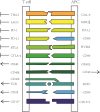Soluble immune checkpoints in cancer: production, function and biological significance
- PMID: 30482248
- PMCID: PMC6260693
- DOI: 10.1186/s40425-018-0449-0
Soluble immune checkpoints in cancer: production, function and biological significance
Abstract
Immune checkpoints play important roles in immune regulation, and blocking immune checkpoints on the cell membrane is a promising strategy in the treatment of cancer. Based on this, monoclonal antibodies are having much rapid development, such as those against CTLA-4 (cytotoxic T lymphocyte antigen 4) and PD-1 (programmed cell death protein 1).But the cost of preparation of monoclonal antibodies is too high and the therapeutic effect is still under restrictions. Recently, a series of soluble immune checkpoints have been found such as sCTLA-4 (soluble CTLA-4) and sPD-1 (soluble PD-1). They are functional parts of membrane immune checkpoints produced in different ways and can be secreted by immune cells. Moreover, these soluble checkpoints can diffuse in the serum. Much evidence has demonstrated that these soluble checkpoints are involved in positive or negative immune regulation and that changes in their plasma levels affect the development, prognosis and treatment of cancer. Since they are endogenous molecules, they will not induce immunological rejection in human beings, which might make up for the deficiencies of monoclonal antibodies and enhance the utility value of these molecules. Therefore, there is an increasing need for investigating novel soluble checkpoints and their functions, and it is promising to develop relevant therapies in the future. In this review, we describe the production mechanisms and functions of various soluble immune checkpoint receptors and ligands and discuss their biological significance in regard to biomarkers, potential candidate drugs, therapeutic targets, and other topics.
Keywords: Cancer; Immune checkpoints; Immunotherapy; Soluble receptors and ligands; T cells.
Conflict of interest statement
Ethics approval and consent to participate
Not applicable.
Consent for publication
Not applicable.
Competing interests
The authors declare that they have no competing interests.
Publisher’s Note
Springer Nature remains neutral with regard to jurisdictional claims in published maps and institutional affiliations.
Figures


References
Publication types
MeSH terms
Substances
LinkOut - more resources
Full Text Sources
Other Literature Sources
Medical
Research Materials
